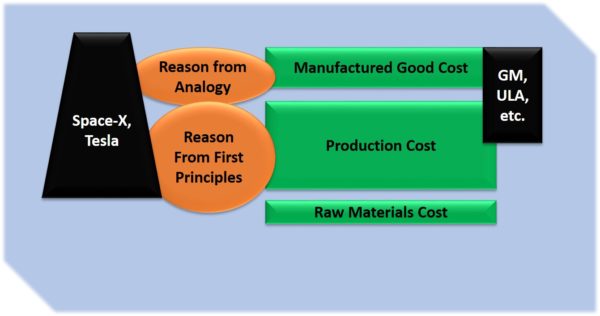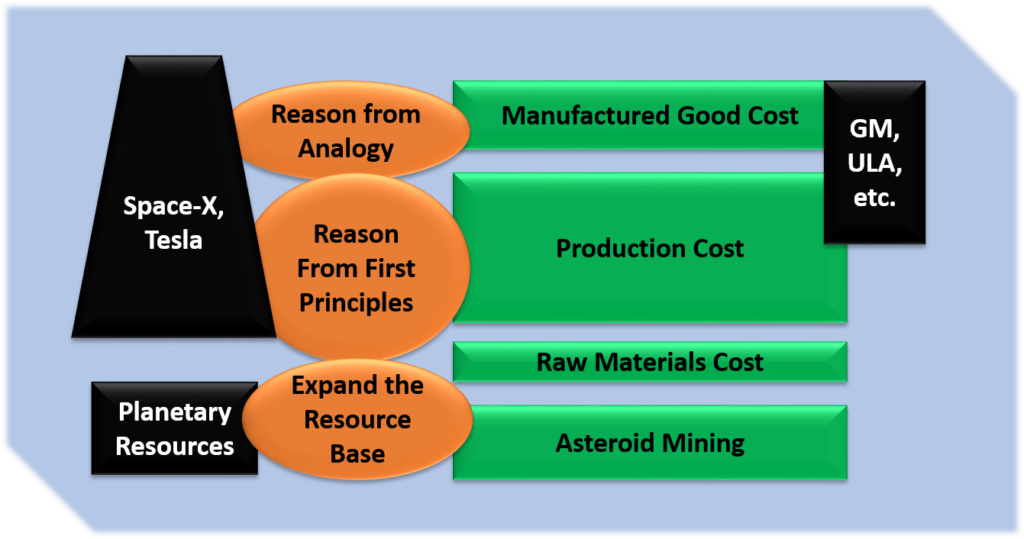
What does Elon Musk mean when he says, "reasoning from First Principles?" It's one of his key business philosophies in determining what industries to disrupt. Let's unpack that and see what it means, historically and in this context.
One goal of this web site is to create the foundation for, “a million mini-Musks” – people who may not be billionaires, but who shake up the world to the degree that they are enabled in constructive and innovative ways. We’ll look at other examples besides Elon Musk, but we’ll start here because it’s an excellent contemporary example of Lesson One.
A Google search on “Elon Musk, First Principles” comes up with 135,000 hits, including this nice summary from LifeHacker – Elon Musk Brainstorming.
“Reasoning from first principles” basically means to break down a problem to it’s most basic components, typically math and matter in the case of an engineering problem. In math, it’s reasoning from axioms and postulates. In logic, it’s reason from a priori assumptions (items that are considered true without further proof) and logical postulates. Both were pioneered in ancient Greece, but the rules have been expanded and brought into other fields. An accident investigation goes through root cause analysis. In physics, reasoning from first principles is a common term, and is also called “reasoning ab initio” or “from the beginning”. It starts with various accepted formulas and builds up to models and experimentation.
An alternative is “reason by analogy”. That states that if X shares attributes with Y, we can interpolate other attributes of Y based on our understanding of X. This is useful if done correctly, and can lead to failure if overextended. It may lead to some innovations, but it will rarely lead to revolutionary inventions unless it jumps from one field to another.
When Elon Musk refers to reasoning from first principles, he breaks down the components of something to the chemical level. A rocket may be X tonnes of aluminum and other materials, and those cost Y amount on the open commodity market. A lithium battery may contain X kilograms of lithium which costs Y amount from a supplier. He then looks at the cost of the finished product – the rocket or the battery, and looks at the value added costs for those two items. If the cost difference is extreme, there is a market opportunity.
In Reasoning by Analogy, we start with the cost of other products on the market in that field, and if they all tend to be the same price, we assume that is the proper price because there are no examples of it not costing that amount. Reason by analogy does not allow for innovation in cost savings unless there is already a product that costs less than the others. Reason by analogy starts with end products already on the market and works backwards to try to find more efficiency in existing methods of production.
Musk argues, and proves with his successes at Tesla and Space-X, that reason from first principles can completely revolutionize a field by re-thinking the most affordable way we can do something at our current level of technology. If your entrenched competitors are simply refining last year’s model, they will never start over and create something revolutionary.
If you want to create an invention that is also an economic opportunity, you must understand both reason from first principles and reason from analogy. You want to be the one doing the reason from first principles when everyone else in the market is doing reason by analogy. Here are two examples to show you what to look for in a market opportunity.
Example of when not to build: The retail material cost of a new workbench is $100 using wood purchased at a hardware store. The store also sells workbenches for $90. Because the manufacturer is buying direct from lumber mills, buying in bulk, and purchasing finished goods from manufacturers using economies of scale and automation. If you are limited in your sources to the hardware store for wood and materials, you cannot profitably go into this business unless you are doing custom work. Alternatively, if you own a lumber mill, you can compare the price you get for lumber versus finished goods and decide if expansion to finished goods is a logical move. While this is rarely the case, we do see lumber distributors investing in precision tools that can cut very thin layers of very expensive wood for use in veneers.
Example of when to build: If your competitors make rockets that cost $300 million to launch 20 tonnes, and you are able to make a rocket that costs $100 million to launch the same payload, you have $200 million in competitive advantage for the existing market. You also have the ability to expand the market to those who cannot afford a $300 million launch vehicle, such as poorer nations or smaller corporations. In hearings before a senate panel, United Launch Alliance (ULA) was questioned as to why their services are so much more expensive for Defense Department satellites than those of Space-X. ULA pointed out that they have special facilities for handling delicate satellites that add to the cost, such as systems that flood the payload fairing with nitrogen to keep the satellite dry and clean while preparing for launch. Musk pointed out that Space-X could have the same facilities built for his systems, but doing so would double the price. That’s still a third cheaper than the two rockets from ULA. The second argument was that ULA has a very reliable pair of launch vehicles with long track records. Space-X has a much newer vehicle with a much shorter record, but it also has a much higher manufacturing rate.
ULA has a limited lifespan under those conditions, so they had to innovate. They have announced a partially-reusable launch vehicle called Vulcan. Ironically, by the time Vulcan is flying, the positions will be reversed and Space-X will have a much longer flight record. The only way for Vulcan, or similar projects from Europe, to be viable is to further increase the flight rate. That means finding roughly four times as many payloads as are currently flown. We will need a revolution in satellite manufacturing, because the current methods for building satellites are matched to the current rate of building launch vehicles.
So Space-X is also going into satellite manufacturing.
Musk chose to go after industries that are able to be revolutionized because they have been working from analogy for 40-90 years. He came from the Internet software services industry, which did not exist twenty years ago. It was also born of the computer age, which is still experiencing exponential growth after fifty years, and has built its methodologies to work efficiently when everything is moving very quickly. Aerospace was exponential for seventy years, but abruptly plateaued around 1972. Automotive engineering is even older. It only became technologically interesting again recently with the addition of computer technology. But the internal combustion engine, like the chemical rocket engine, was refined by analogy for decades with few new inventions. As the information age begins to level the curve of Moore’s Law, investment looks for new opportunities. The collision was natural, and has been mimicked in some ways by Google’s investments in satellites and launchers, Amazon/Blue Origin, and so on. I chide Apple that they are the only large Silicon Valley computer company without a space program. Even they are looking at cars, though.
As we dive deeper into invention and innovation, and the history of it, we will find that Musk is not alone. First Principles are mirrored in nearly every dramatic innovation. Nor is it Musk’s only strategy.
Interestingly, the old “reason by analogy” companies are starting to reason by the new analogies provided by Space-X and Tesla. The Chevy Volt was created because an executive at GM questioned his engineers that, “If a tiny company in California can do this, why can’t we?”

What if you go past the “raw material cost” line and move it as well? Platinum and other precious metals are exceedingly rare on Earth, but can be found in abundance in some asteroids. By mining asteroids, we can actually expand the raw material supply and therefore lower the cost via the law of supply and demand. If platinum were half or a tenth the price, we will eventually find new practical uses for it. Planetary Resourcesgoes to the heart of the matter concerning rare materials. Such systems may eventually become cost effective due to cheaper launch vehicles from Space-X and their competitors.
Or as they used to say in the L5 Society (before it became part of the National Space Society) – “Ninety percent of the materials available to humanity are not on Earth.”